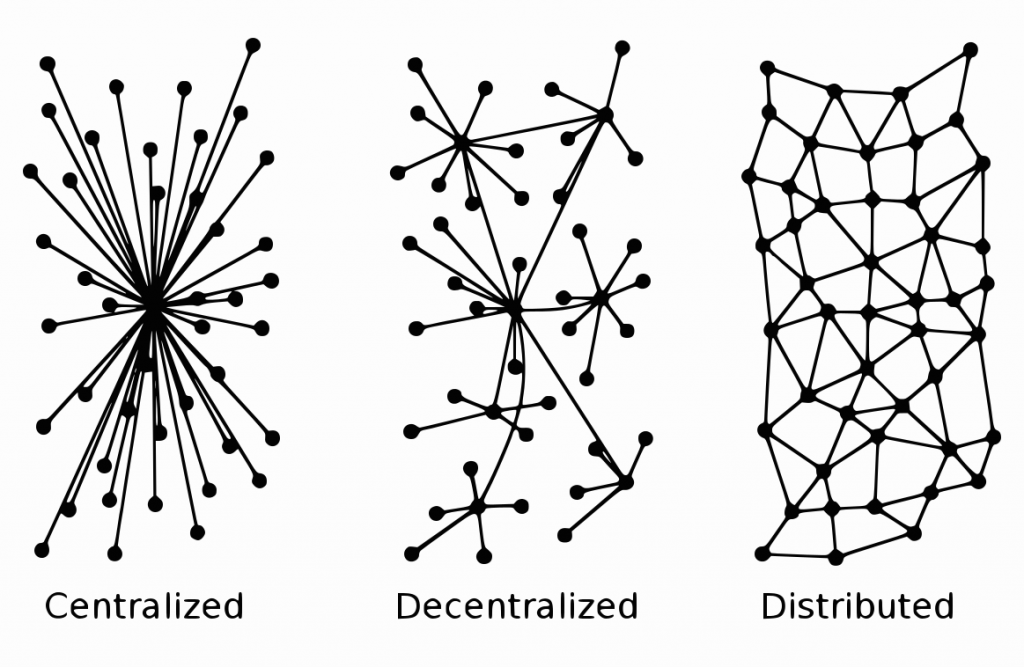During the mid-00s you may have interacted with hundreds of websites and applications and services on your PC from one month to the next. As of 2016, US citizens spent two thirds of their digital time on their phones rather than a desktop or laptop, and the majority of that time was spent in apps rather than browsing the web [Comscore, 2016]. The majority of our attention in Europe and America is commanded by just a few companies (frequently referred to as ‘the big five’ — Google, Facebook, Apple, Amazon, Microsoft) most of which are working to develop a new layer above those apps, or more accurately above the purveyors of those apps. They have innovated, acquired, and aggregated, using a network effect in one market to build a massive customer base for another.
A network effect describes the situation in which the value of a product or service increases with the number of others using it. Such centralization doesn’t mean anyone is behaving badly, it’s just the network effect playing out. (Of course things can have network effects without any one company owning it – the Web itself being the classic example.)
This is due to its core importance in many fields of study. Essentially though, decentralization is the process of moving information, power or resources through more parts of a network so that no one node can dominate. Decentralization, in spite of the cumbersome word, is the key to resilience, whether in living networks or technological ones. Decentralization is the process of moving information, power or resources through more parts of a network so that no one node can dominate.
Decentralization is an important concept for both the Internet and the Web. In the words of the title of an article written for the World Wide Web Foundation in 2016, decentralization is a deep cause of causes you care about deeply.
Unlike a centralized network, a decentralized network doesn’t have one central component through which everything passes. A famous diagram by Paul Baran, a prominent engineer in the development of the Internet, shows three forms of network.

Think about these three forms as sitting on a spectrum representing the leftmost (centralized), middle (decentralized) and rightmost (distributed) positions, with networks in the real world spanning the full spectrum with the majority falling somewhere in-between the extremes.
Note that while decentralized is then midway between totally centralized and fully distributed, use of the verb to decentralize often describes that journey from left to right including progression right of the middle. As more nodes are connected, the failure of one node impacts the network less and less, increasing the resilience of the network.
Many visionaries have understood the power of decentralization over the years. Aldous Huxley regarded the decentralization of industry and government necessary for a better society (1937). Norbert Wiener’s insights into the dynamics and ethics of humans and large computer systems hinted at the advantages (1950). Marshall McLuhan anticipated a shift from the centralized mechanical age to the decentralized electronic age, coining the term global village as shorthand for such a welcome outcome (1962). E.F. Schumacher considered decentralization allied with freedom and one of “the truths revealed by nature’s living processes” (1973).
The Internet was designed as a distributed network. And the World Wide Web (that runs on top of the Internet) is in parts both decentralized and distributed.
Why is decentralization core to the design of the Internet and World Wide Web? Well, for each of these three types of network just ask yourself – how many dots would I need to erase to disable the entire network? Distributed networks are more resilient.
The US Department of Defense played a major role in funding the development of the Internet, so you can see now why a distributed network was chosen – a distributed network can simply ‘route around’ any erased dots / destroyed facilities, carrying on doing what it was doing before [Reliable Digital Communications Systems Using Unreliable Network Repeater Nodes, Paul Baran, The Rand Corporation].
The Web Foundation describes a key feature of the World Wide Web:
No permission is needed from a central authority to post anything on the Web, there is no central controlling node, and so no single point of failure … and no “kill switch”! This also implies freedom from indiscriminate censorship and surveillance.
Given that decentralization and distributed architecture is core to the very definitions of the Internet and the Web, to watch growing centralization is to witness their erosion. With just a few companies setting themselves up at the center of all things, we have less opportunity to do anything that doesn’t involve them, contrary to our definition of Tech We Trust.